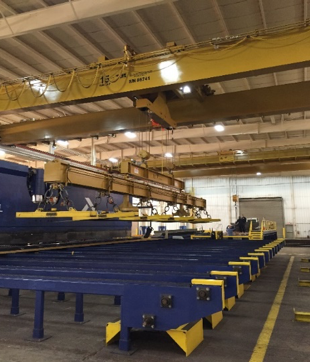
Below-the-hook (BTH) lifting devices are important attachments that facilitate the efficient and safe transportation of various types of loads. They include coil hooks, coil grabs, mechanical lifters, spreader bars, and magnet lifts used in conjunction with cranes and hoists.
T&M Cranes offers below the hook solutions from manufacturers such as Caldwell, Bradley, Drafto and Bushman. We help many of our customers in steel mills and foundries, steel service centers, manufacturing and fabricating, and paper mill industries improve both the efficiency and safety of both lifts and loads.
There’s a wide variety of below-the-hook lifter applications, which is why there are different types of below-the-hook lifting devices. Most manufacturers produce standard lifting devices configured to handle common lifting tasks such as lifting and moving bars or pipes, stacking coils, sheets and plates, and moving pallets and various structural shapes.
Customized below-the-hook devices are also quite common. These are engineered lifters designed to pick up and transport very specific loads.
The size, shape, weight or center of gravity of the load can all impact how a custom-built below-the-hook device is manufactured.

Types of below-the-hook devices and their uses
Our engineering and sales staff take the time to fully understand your application before recommending the best below-the-hook devices and to solve your most difficult problems.
Below-the-hook lifting devices standards
T&M Cranes’ experienced engineering staff will work with you to make sure your design meets your expectations. We are especially experienced custom designed solutions that are utilized in heavy and even severe environments and adhere to all standards.
Due to the critical function of these attachments, there are below-the-hook lifting device standards that pertain to individual designs and specific marking requirements that manufacturers must adhere to. ASME B30.20 and ASME BTH-1 (named after the American Society of Mechanical Engineers) are the two most important standards when it comes to the design and markings of a below-the-hook lifting device.
A lifting yoke, lifting basket, spreader bar, or lift fixture, for example, must individually bear its own rated capacity. It should also, at the very least, have a name tag or plate, or some other permanent marker showing the following data:
At T&M Cranes, we specialize in manufacturing all types of overhead cranes and related components. If you require a customized below-the-hook lifting device or have questions about any of our products and services, please reach out to one of our industry specialists.